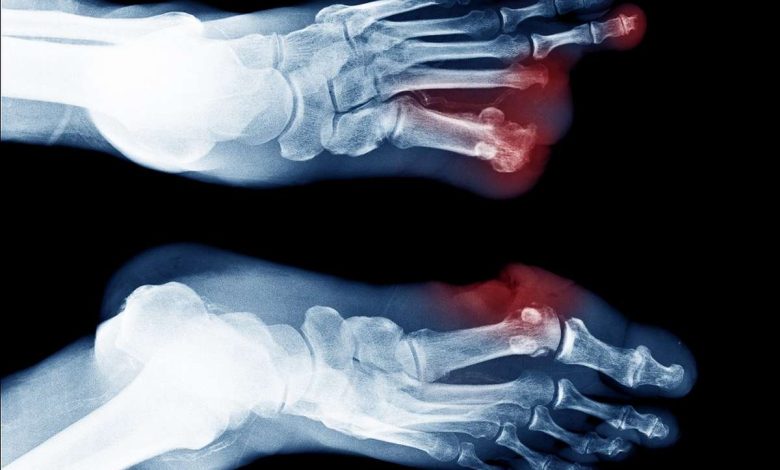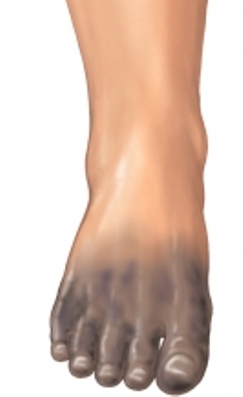Amputation of the foot or toe: what is this operation, causes, Contraindications, how they do it, what after

Description amputation of the foot or toe
When this operation is surgically removed toe, rate, or leg.
Indications for amputation of the foot or toe
Amputation is most often performed for the purpose of:
- Treatment of infections;
- Remove dead or damaged tissue, which can lead to gangrene.

Possible complications
Complications are rare, However, if you plan to do an amputation, You need to know, they may include:
- Difficulties with healing place amputation;
- Infection;
- Pain cults (severe pain in the remaining tissue);
- Phantom pain – feeling pain in amputated limbs;
- Continued spread of gangrene, requiring more leg amputation, fingers or toes;
- Bleeding;
- Nerve Damage;
- Claudication (whichever, which part of the foot or the finger has been removed);
- Deformation and contractures (decreased mobility) joints.
Factors, that may increase the risk of complications include:
- Smoking;
- Infection;
- Diabetes;
- Poor blood circulation;
- Bleeding;
- Heart problems or high blood pressure;
- Renal failure;
- Obesity;
- Advanced age.
How is the amputation of the foot or toe?
Preparation for the procedure
Before the surgery, the doctor may do tests:
- Blood tests;
- X-ray of the legs and feet;
- A bone scan, to see, Is there an infection in the bones;
- Tests for the assessment of blood circulation helps your doctor determine, which part of the foot or leg to be amputated.
It may be necessary to adjust the dose or stop taking certain drugs, such as:
- Aspirin or other anti-inflammatory drugs (perhaps, It needs to stop taking one week before surgery);
- Blood-thinning medicines, such as:
- Clopidogrel;
- Warfarin;
- Ticlopidine.
In just a few days before surgery:
- It is necessary to prepare the conditions for the rehabilitation of the house after returning from the hospital;
- It is necessary to follow the instructions, do not take food for twelve hours before the operation;
- Maybe, it will be necessary to use antibacterial soap for several days prior to surgery.
Anesthesia
Depending on the condition of the patient, may apply one of the following types of anesthesia:
- The operation is performed under general anesthesia, during the operation the patient is asleep;
- Local anesthesia – analgesia particular area or portion of the body;
- Spinalynaya anesthesia – analgesia lower body.
Procedure amputation
Before the surgery, intravenous introducing the necessary drugs and antibiotics. Leg clean antibacterial solution. The surgeon makes an incision of the skin around the affected area. Blood vessels is compressed or is isolated by using electric current to prevent bleeding. The damaged bone is removed.
End ostayushteysya bones (bones) smoothed. The remaining skin and muscle they cover the open area, and sshyvayut paths. Slitting Rewinding sterile dressing.
If there is active infection, It can be cut into thin tubes inserted, allows fluid to drain. In some cases, the skin is sutured, and it is applied wet dressing.

Immediately after foot or toe amputation surgery
After surgery, the patient is sent to the recovery room, to monitor the vital parameters. If you want to introduce antibiotics and drugs. When the condition is stabilized, the patient is transferred to the general hospital ward.
How long does it take to amputate a foot or toe?
The operation lasts 20-60 minutes.
Will it hurt?
Anesthesia will prevent pain during surgery. For pain relief after surgery appoint appropriate painkillers. There may be a phantom pain at the site of the amputated body. For their treatment should consult a doctor.
The time spent in hospital
From 2 to 7 days – depending on potential or established complications.
Postoperative care after foot or toe amputation
In the hospital
- The foot will be raised above the body suspension;
- The finger or foot will be bandaged. This will protect them from accidental injury;
- Carry out the procedure for the prompt lifting his feet;
- At the initial stage, when walking, You may need the help of a physiotherapist.
Home Care
Houses need to fulfill the following requirements, to ensure the normal recovery:
- Maybe, I have to wear a plaster, a special postoperative shoe, until stitches are removed. The sutures are usually removed within three weeks after amputation;
- You must check with your doctor, when it is safe to shower, bath, place or subject to water amputation;
- It is recommended to start to do the exercises to preserve the mobility of the feet, undergo physiotherapy, or rehabilitation programs;
- Should quit smoking;
- It is necessary to follow the doctor's instructions.
It is necessary to go to the hospital in the following cases:
- The emergence of symptoms of infection, including fever and chills;
- Redness, naʙuxanie, pain, bleeding, or discharge from the surgical site;
- The appearance of white or blackish spots on foot, fingers, or rates;
- Reduced sensitivity, numbness, or tingling in the rest of the leg, toes, or rates;
- Nausea and / or vomiting, which last more than one day after the release from the hospital;
- Strong pain, does not pass, even after use of painkillers;
- Pain, burning, frequent urination, or blood in the urine;
- Cough, breathlessness, or chest pain;
- Joint pain, fatigue, stillness, rash, or other unpleasant symptoms.
